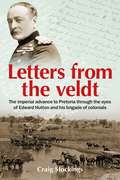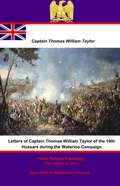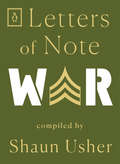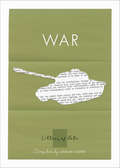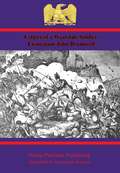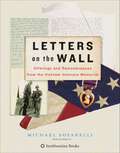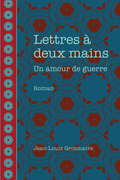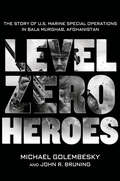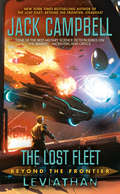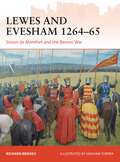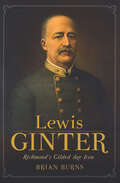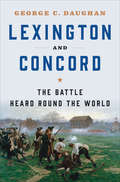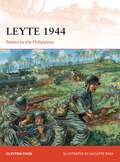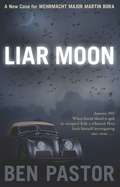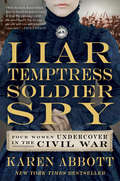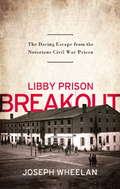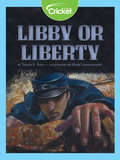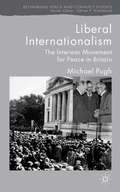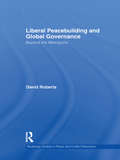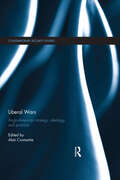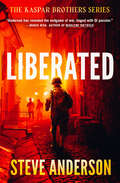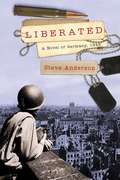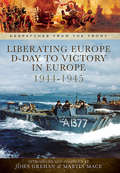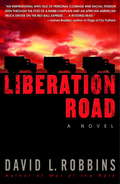- Table View
- List View
Letters from the Veldt: The imperial advance to Pretoria through the eyes of Edward Hutton and his brigade of colonials.
by Craig StockingsThe South African War – or Boer War – running from 11 October 1899 until 31 May 1902 –was the largest British military effort since the Napoleonic Wars. It was also the first time that large-scale, meaningful contributions were made to an active theatre of war by the self-governing colonies. This included formal contributions of around 20,000 troops from the Australian colonies which dwarfed all previous Australian military commitments. Just as the war was a watershed event for the development and professionalisation of the British Army from 1902-14, it was momentous for the self-governing colonies in Australia and elsewhere in social, political and most certainly in military terms.Letters from the Veldt sheds light on the activities of imperial military contingents – in which Australians served – during the Imperial march to Pretoria from May-September 1900, the successful conclusion of which marked the end of &‘conventional&’ operations in South Africa and the beginning of the &‘guerrilla&’ phase that would drag on until May 1902. A large proportion of colonial troops serving in South Africa at this point did so as part of the 1st Mounted Infantry Brigade. Despite their importance, the experiences of this brigade have not figured largely in existing any accounts of the Boer War. The brigade itself was composed of not only Australians, but Canadians, New Zealanders, and British regular and volunteer troops, and a scattering of &‘loyal&’ South Africans. It was in many ways a microcosm of imperial military cooperation; an important part of the steady development of attitudes, expectations and shared experience which led to the formation in 1914 of a much larger expeditionary force. This account does not follow a standard pattern or format – there is no measured, steady traditional narrative. Rather, the experiences of the 1st Mounted Infantry Brigade, and the light they shed on many wider issues, are presented through letters written home by its British commander, Major General Edward Thomas Henry &‘Curly&’ Hutton – himself a little-known yet key figure in the early history of the Australian military. Read within their context, the Boer War letters of Major General Edward Hutton offer a window not only into the course and conduct of the imperial advance to Pretoria, but also a lens through which to better understand a range of wider issues that framed his world – the world of Australian military history before the term Anzac was coined.
Letters of Captain Thomas William Taylor of the 10th Hussars during the Waterloo Campaign
by Major-General Thomas William Taylor C.B.This ebook is purpose built and is proof-read and re-type set from the original to provide an outstanding experience of reflowing text for an ebook reader. Jonathan Leach's service with the 95th Rifles throughout the Peninsular and Waterloo campaigns placed him in an authoritative position to write a short exposition on the Field Services of the Rifle Brigade. Although brief the document is a valuable addition to the works on this famous corps. Text taken whole and complete from the 1838 edition
Letters of Note: War (Letters of Note #4)
by Shaun UsherA powerful new volume of missives about combat by Alexander Hamilton, General Sherman, Evelyn Waugh, Kurt Vonnegut, and more, from the author of the bestselling Letters of Note collectionsDefeated Cossacks taunt the pompous sultan of the Ottoman Empire. A black corporal beseeches Abraham Lincoln to ensure that his regiment receives proper payment for performing their duties. Mohandas Gandhi urges Adolf Hitler to turn back the tide of war. A suicide bomber in Iraq explains his simple motivation to his family. This poignant collection offers a nuanced and moving look at the act of armed conflict. Each of these 30 remarkable letters sheds light on what it means for us to take up arms against one another and record a piece of that terrible deed. They encapsulate the full experience of battle, from feats of courage and sacrifice to the grief that follows acts of violence, ultimately affirming the power of the written word.
Letters of Note: War (Letters of Note)
by Shaun UsherA compilation of remarkable letters with love at their heart, from the curator of the globally popular Letters of Note website.The first volume in the bestselling Letters of Note series was a collection of hundreds of the world's most entertaining, inspiring, and unusual letters, based on the seismically popular website of the same name--an online museum of correspondence visited by over 70 million people. From Virginia Woolf's heartbreaking suicide letter, to Queen Elizabeth II's recipe for drop scones sent to President Eisenhower; from the first recorded use of the expression 'OMG' in a letter to Winston Churchill, to Gandhi's appeal for calm to Hitler; and from Iggy Pop's beautiful letter of advice to a troubled young fan, to Leonardo da Vinci's remarkable job application letter. Now, the curator of Letters of Note, Shaun Usher, gives us wonderful new volumes featuring letters organized around a universal theme.In this volume, Shaun Usher turns to the subject of love. What emotion inspires humans to put pen to paper more than love? It's unsurprising that love letters provide an endless source of extraordinary writing. Letters of Note: Love gathers together some of the most powerful messages about love ever composed, whether inspired by love's first blush or the recriminations at its ending, the regrets of unrequited feelings and the joys of passions known. Includes letters by Zora Neale Hurston, Napoleon Bonaparte, Frida Kahlo, Nelson Mandela, and many more.
Letters of a Weardale Soldier, Lieutenant John Brumwell
by William Morley Egglestone Lieutenant John BrumwellThis ebook is purpose built and is proof-read and re-type set from the original to provide an outstanding experience of reflowing text for an ebook reader. There is something particularly affecting when reading the posthumously published letters of a soldier who has fallen in battle. The hope of a future rings out clear from John Brumwell's letters back to his family in the north of England whilst he toils in the Duke of Wellington's army in Spain and Portugal, only to be cut short in 1812, two years short of peace. Local historian William Eggleston unearthed these letters still held in the same locality that Lieutenant Brumwell's family lived and wove them into a short book which contains much of the fallen officers' family background and connecting narrative explaining the war during which the letters were written. A short but worthwhile read. Title - Letters of a Weardale Soldier, Lieutenant John Brumwell Author -- Lieutenant John Brumwell (????-1812) Editor -- William Morley Egglestone (1838-????) Text taken, whole and complete, from the edition published in 1912, Stanhope Co. Durham, by the editor. Original - iii and 103 pages. Illustrations - 8 illustrations.
Letters on the Wall: Offerings and Remembrances from the Vietnam Veterans Memorial
by Michael SofarelliSince its creation in 1982, the Vietnam Veterans Memorial has become the most visited National Park Services site. Each year, 4.5 million people come to the Wall. Many of them leave letters or other special objects. Every night, park rangers collect and inventory these mementos—now numbering well over 90,000—and put them into government storage.Michael Sofarelli, the son of a Vietnam War veteran, has combed through the archives searching for the most gripping letters and objects: a mother awaiting word of her missing son, a former comrade recounting a battle story, a pair of well-worn ballet slippers, and a collection of cigars. These items are not only a tribute to the fallen soldiers; they pay tribute as well to the families and friends who waited at home and the comrades who have never forgotten their brothers. They tell the story of a war that is still being fought by many who served and a conflict that changed the lives of many Americans forever.
Lettres à deux mains: un amour de guerre
by Monsieur Jean-Louis GrosmaireAprès avoir lu les lettres que son grand-père écrivait à sa grand-mère durant la Première Guerre mondiale, Jean-Louis Grosmaire a décidé d'en faire un livre, un hommage à « ces hommes et ces femmes emportés dans les tourbillons belliqueux ». Dans ses lettres à la fois tendres et inquiètes, le paysan devenu caporal raconte les tranchées, les barbelés, les obus, le froid et la peur. Il écrit aussi son amour à sa jeune épouse, enceinte d'un deuxième enfant. Certaines lettres, celles qui sont datées, sont authentiques. Les autres sont le fruit de l'imagination de l'écrivain.
Level Zero Heroes: The Story of U.S. Marine Special Operations in Bala Murghab, Afghanistan
by John R. Bruning Michael GolembeskyAn elite Marine special operations team, a battle to save downed soldiers in Afghanistan, a fight for survival—an incredible true story of war that became a New York Times bestseller.In Level Zero Heroes, Michael Golembesky follows the members of U.S. Marine Special Operations Team 8222 on their assignment to the remote and isolated Taliban stronghold known as Bala Murghab as they conduct special operations in an effort to break the Taliban's grip on the Valley. What started out as a routine mission changed when two 82nd Airborne Paratroopers tragically drowned in the Bala Murghab River while trying to retrieve vital supplies from an air drop that had gone terribly wrong. In this one moment, the focus and purpose of the friendly forces at Forward Operating Base Todd, where Team 8222 was assigned, was forever altered as a massive clearing operation was initiated to break the Taliban's stranglehold on the valley and recover the bodies.From close-quarters firefights in Afghan villages to capturing key-terrain from the Taliban in the unforgiving Afghan winter, this intense and personal story depicts the brave actions and sacrifices of MSOT 8222. Readers will understand the hopelessness of being pinned down under a hail of enemy gunfire and the quake of the earth as a 2000 lb. guided bomb levels a fortified Taliban fighting position. A powerful and moving story of Marine Operators doing what they do best, Level Zero Heroes brings to life the mission of these selected few that fought side-by-side in Afghanistan, in a narrative as action-packed and emotional as anything to emerge from the Special Operations community contribution to the Afghan War.
Leviathan (Trilogía Leviathan parte I)
by Scott Westerfeld Keith Thompson Raquel Solá GarcíaNos encontramos en la cúspide de la Primera Guerra Mundial y todas las potencias europeas se están armando. Los austrohúngaros y alemanes tienen sus clánkers, unas máquinas de acero con motores de vapor cargados de armas y municiones. Los darwinistas británicos emplean animales fabricados como armas de guerra. Su Leviathan es un dirigible ballena, la bestia más poderosa de la flota británica. Aleksandar Ferdinand, príncipe del Imperio austrohúngaro ha huido. Su propia gente se ha vuelto contra él. Su título no tiene ya ningún valor y solo cuenta con un Caminante de Asalto desgastado por la batalla y con su leal tripulación. Deryn Sharp es una plebeya, una chica disfrazada de chico que se ha alistado en las Fuerzas Aéreas británicas. La muchacha es un destacado aviador, pero su secreto se encuentra en peligro constante de ser descubierto. Cuando la Gran Guerra es ya inminente, los caminos de Alek y Deryn se cruzan de la forma más inesperada llevándolos a ambos a bordo del Leviathan donde darán la vuelta al mundo y vivirán una fantástica aventura que cambiará sus vidas para siempre.
Leviathan: Lost Fleet (Beyond the Frontier #5)
by Jack CampbellTwo Syndicate World star systems have fallen prey to a mysterious fleet of warships--a fleet controlled entirely by artificial intelligence--that is now targeting Alliance space. <P><P>The warships are no mystery to Geary. They were developed by his government to ensure security, but malfunctioned. If the Syndics learn the truth, the war with the Alliance will resume with a vengeance. As the government attempts to conceal the existence of the A.I. warships--and its role in their creation--Geary pursues them, treading a fine line between mutiny and obedience. <P>But it soon becomes clear that his fleet is no match for the firepower of the machine-piloted armada.With the help of the Dancer species of aliens, Geary has tracked the A.I. ships to their secret base in the supposedly mythical Unity Alternate star system where his fleet, the last hope of the Alliance's future, will end the conflict at any cost...
Lewes and Evesham 1264-65
by Richard BrooksAt the crescendo of the Second Barons' War were the battles of Lewes and Evesham. It was an era of high drama and intrigue, as tensions between crown and aristocracy had boiled over and a civil war erupted that would shape the future of English government. In this detailed study, Richard Brooks unravels the remarkable events at the battles of Lewes and Evesham, revealing the unusually tactical nature of the fighting, in sharp contrast to most medieval conflicts which were habitually settled by burning and ravaging. At Lewes, Simon de Montfort, the powerful renegade leader of the Baronial faction, won a vital victory, smashing the Royalist forces and capturing Henry III and Prince Edward. Edward escaped, however, to lead the Royalist armies to a crushing victory just a year later at Evesham. Using full color illustrations, bird's eye views and detailed maps to generate an arresting visual perspective of the fighting, this book tells the full story of the battles of Lewes and Evesham, the only pitched battles to be fought by English armies in the mid-13th century.
Lewis Ginter: Richmond's Gilded Age Icon
by Brian BurnsA biography of the nineteenth-century influential Richmond businessman.As a Confederate war hero, philanthropist and entrepreneur, Lewis Ginter was many things to Richmond. Performing integral missions for &“Stonewall&” Jackson and Robert E. Lee, Ginter was commended for gallantry on the battlefield and became affectionately known as the &“Fighting Commissary.&” After the war, Ginter was the first major marketer of the hand-rolled cigarette in America. He developed one of America&’s first streetcar suburbs and built the magnificent Jefferson Hotel, a symbol of Richmond&’s ambition and prosperity. But beyond the well-known history of this River City icon, there are many aspects of his personal and professional life that few know about. Join local writer Brian Burns as he delves into the hidden history of Ginter&’s extraordinary life to fill in the gaps between Ginter the man and Ginter the legend.&“By using many original sources, [Burns] writes of details of Ginter's life that even longtime Richmond-history buffs may not know.&” —Richmond Times-Dispatch
Lexington and Concord: The Battle Heard Round The World
by George C. DaughanAn award-winning historian reinterprets the battle that launched the American Revolution. George C. Daughan’s magnificently detailed account of the Battle of Lexington and Concord challenges the prevailing narrative of the American War of Independence. It was, Daughan argues, based as much in economic concerns as political ones. When Massachusetts militiamen turned out in overwhelming numbers to fight the British, they believed they were fighting for their farms and livelihoods, as well as for liberty. Benjamin Franklin was not surprised by this widespread belief. In the years prior to the Revolution, Franklin had toured Great Britain and witnessed the wretched living conditions of the king’s subjects. They wore rags for clothes, went barefoot, and had little to eat. They were not citizens, but serfs. Franklin described the appalling situation in a number of letters home. In the eyes of many American colonists, Britain’s repressive measures were not seen simply as an effort to reestablish political control of the colonies, but also as a means to reduce the prosperous colonists themselves to the serfdom described in the Franklin letters. Another key factor in the outcome of this historic battle, according to Daughan, was the scorn British officers had for colonial fighters. Although the British officers had fought alongside colonial Americans in the ferocious French and Indian War, they failed to anticipate the skill, organization, and sheer numbers of the colonial militias. Daughan explains how British arrogance led them to defeat at the hands of motivated, experienced patriot fighters determined to protect their way of life. Authoritative and immersive, Lexington and Concord gives us a new understanding of a battle that became a template for colonial uprisings in later centuries.
Leyte 1944
by Clayton ChunThe loss of the Phillipines in 1942 was the worst defeat in American military history. General Douglas MacArthur, the 'Lion of Luzon', was evacuated by order of the President just before the fall, but he vowed to return, and in August 1944 he kept his word when he led the largest amphibious assault of the Pacific War to date on the island of Leyte. This is the full story of that fateful battle, one of the most ferocious campaigns of World War II and one of huge strategic and symbolic significance. Preceding it had been the largest naval battle ever fought: the battle of Leyte Gulf, in which the Imperial Japanese Navy was decisively crushed. This paved the way for four divisions of Lieutenant-General Krueger's Sixth Army to spear-head the assault. In the face of stubborn Japanese resistance, including the first systematic use of kamikaze attacks, the US forces ground slowly forwards before another amphibious assault took the vital position of Ormoc in the last decisive battle of the campaign. Based on extensive research in the US Army's Military History Institute, along with other archival and veteran sources, this important study sheds new light on the operation that saw the US finally return to the Phillipines and in doing so placed another nail firmly in the coffin of the Japanese Empire.
Liar Moon
by Ben PastorPraise for Ben Pastor's Lumen: "Pastor's plot is well crafted, her prose sharp. . . . A disturbing mix of detection and reflection."--Publishers Weekly "Rivets the reader with its twist of historical realities. A historical piece, it faithfully reproduces the grim canvas of war. A character study, it captures the thoughts and actions of real people, not stereotypes."--The Free Lance-Star "And don't miss Lumen by Ben Pastor. . . . An interesting, original, and melancholy tale."--Literary Review Italy, September 1943. The Italian government switches sides and declares war on Germany. The north of Italy is controlled by the fascist puppets of Germany; the south liberated by Allied forces fighting their way up the peninsula. Having survived hell on the Russian front, Wehrmacht major and aristocrat Baron Martin von Bora is sent to Verona. He is ordered to investigate the murder of a prominent local fascist: a bizarre death threatening to discredit the regime's public image. The prime suspect is the victim's twenty-eight-year-old widow Clara. Haunted by his record of opposition to SS policies in Russia, Bora must watch his step. Against the backdrop of relentless anti-partisan warfare and the tragedy of the Holocaust, a breathless chase begins. Ben Pastor, born and now back in Italy, lived for thirty years in the United States, working as a university professor in Vermont. The first in the Martin Bora series, Lumen, was published by Bitter Lemon Press in May 2011.
Liar, Temptress, Soldier, Spy: Four Women Undercover in the Civil War
by Karen AbbottKaren Abbott, the New York Times bestselling author of Sin in the Second City and “pioneer of sizzle history” (USA Today), tells the spellbinding true story of four women who risked everything to become spies during the Civil War.Karen Abbott illuminates one of the most fascinating yet little known aspects of the Civil War: the stories of four courageous women—a socialite, a farmgirl, an abolitionist, and a widow—who were spies.After shooting a Union soldier in her front hall with a pocket pistol, Belle Boyd became a courier and spy for the Confederate army, using her charms to seduce men on both sides. Emma Edmonds cut off her hair and assumed the identity of a man to enlist as a Union private, witnessing the bloodiest battles of the Civil War. The beautiful widow, Rose O’Neale Greenhow, engaged in affairs with powerful Northern politicians to gather intelligence for the Confederacy, and used her young daughter to send information to Southern generals. Elizabeth Van Lew, a wealthy Richmond abolitionist, hid behind her proper Southern manners as she orchestrated a far-reaching espionage ring, right under the noses of suspicious rebel detectives.Using a wealth of primary source material and interviews with the spies’ descendants, Abbott seamlessly weaves the adventures of these four heroines throughout the tumultuous years of the war. With a cast of real-life characters including Walt Whitman, Nathaniel Hawthorne, General Stonewall Jackson, detective Allan Pinkerton, Abraham and Mary Todd Lincoln, and Emperor Napoleon III, Liar, Temptress, Soldier, Spy draws you into the war as these daring women lived it.Liar, Temptress, Soldier, Spy contains 39 black & photos and 3 maps.
Libby Prison Breakout: The Daring Escape from the Notorious Civil War Prison
by Joseph WheelanWhile many books have been inspired by the horrors of Andersonville prison, none have chronicled with any depth or detail the amazing tunnel escape from Libby Prison in Richmond. Now Joseph Wheelan examines what became the most important escape of the Civil War from a Confederate prison, one that ultimately increased the North’s and South’s willingness to use prisoners in waging "total war. ” In a converted tobacco warehouse, Libby’s 1,200 Union officers survived on cornbread and bug-infested soup, and slept without blankets on the bare floor. With prisoner exchanges suspended, escape and death were the only ways out. Libby Prison Breakout recounts the largely unknown story of the escape of 109 steel-nerved officers through a 55-foot tunnel, and their flight in winter through the heart of the enemy homeland, amid an all-out Rebel manhunt. The officers’ later testimony in Washington spurred two far-reaching investigations and a new cycle of retaliation against Rebel captives.
Libby or Liberty
by Tracey E. FernUnion Colonel Thomas E. Rose was captured in a Civil War battle and thrown in the brutal and secure Libby Prison. He quickly realizes that tunneling out is the only way to escape and joins forces with Major A. G. Hamilton to begin digging to freedom.
Liberal Internationalism: The Interwar Movement for Peace in Britain (Rethinking Peace and Conflict Studies)
by Michael C. PughThe book investigates the role of popular liberal internationalism as a social movement in Britain using Gramscian and Foucauldian ideas of civil society. It addresses the use of force for peace through an examination of the impact of civil society actors in popular liberal internationalism between the world wars.
Liberal Peacebuilding and Global Governance: Beyond the Metropolis (Routledge Studies in Peace and Conflict Resolution)
by David RobertsThis book examines the limits to cosmopolitan liberal peacebuilding caused by its preoccupation with the values and assumptions of neoliberal global governance. The peace people experience is determined by the processes privileged in peacebuilding. This book is about four things that shape the processes involved. First, it is a critique of orthodox postconflict peacebuilding. It takes the position that the present approach, although seemingly hegemonic, is routinely ignored or manipulated by elites and society and converted into a miasma that to some degree wastes the energies and opportunities involved. Second, it is about alternatives which invoke the kind of peace people might seek in postconflict places if they had more control over the process of peacebuilding, a notion referred to here as ‘popular peace’. It is thus not the kind of critical work that some describe as ‘reflexive anti-liberalism’. Rather, it seeks alternatives that are grounded in the lives of people in postconflict spaces and which also reflect some of the essential values of Liberalism. Third, it is about the role of both informal and formal actors, institutions and practices in the creation of such a peace. For instance, it is concerned with the legitimacy of informal practices that lie beyond Liberal tolerance and which are vital in the pursuit of everyday peace. Fourth, it is about a ‘transversal’ (rather than vertical or hierarchical) relationship of global and local governance in securing a peace that reflects the needs and values of both. In short, this work is a response to the substantial inconsistencies that appear between peacebuilding rhetoric and everyday outcomes in postconflict places. This book will be of much interest to students of peacebuilding, post-conflict statebuilding, conflict studies, global governance and International Relations in general.
Liberal Wars: Anglo-American Strategy, Ideology and Practice (Contemporary Security Studies)
by Alan CromartieThis book addresses the relationship between the 'liberal' values of Anglo-Saxon cultures and the way that they conduct themselves when they are fighting - or preparing to fight - wars. The United States and the United Kingdom are characterised by a consensus that their social and political arrangements are, in a very broad sense, ‘liberal’. Liberalism is not pacifism; nor are liberals necessarily respectful of traditional prohibitions that have set out to moderate excessive violence. But liberals do seek to understand their violent actions as part of a wider project of defending or expanding liberal freedoms. The perceived alternative is to undermine the will to keep on fighting. Sustaining a liberal picture of what is going on is an indispensable part of a liberal strategy. Contributors with disciplinary backgrounds in history, international relations, and strategic studies discuss what ‘liberalism’ means in this particular context and how it might relate to ‘strategy’, both in the recent past and in the future. The chapters consider how liberal states understand the wars they fight, the constraints liberal values place on these states, the role of public opinion and the appropriate strategies for modern liberal states. Topics addressed include civilian bombing, the nature of US military culture, the British ‘Iraq inquiries’, the effects of the erosion of Westphalian sovereignty and the rise of new ideas about ‘globalization’, and the decline in popular involvement. This book will be of much interest to students of strategic studies, political philosophy, foreign policy, security studies and IR in general.
Liberated (The Kaspar Brothers)
by Steve AndersonAn American captain in post-WWII Germany must stop a criminal conspiracy by his fellow officers in this historical thriller by the author of The Losing Role. Germany, May, 1945. With the war just over, Capt. Harry Kaspar is about to take a new posting in the US occupation—running a Bavarian town named Heimgau. When Harry loses the command to a rival, he&’ll do almost anything to win the job back. Then Harry discovers a horrific scene: three German men tortured and murdered. Solving the crime could teach the locals about American justice—and help him reclaim his posting. But as Harry&’s quest for the killer leads him back to American officers, he uncovers a criminal network plundering the war-torn land for all its worth. Now, for justice to mean anything at all, Harry must fight back.
Liberated: A Novel of Germany, 1945 (Kaspar Brothers Ser.)
by Steve AndersonCan a lone American captain rescue justice in war-torn Germany?It's May 1945, the war's just over, and Harry Kaspar, an American captain in Germany, is about to take a new posting in the US occupation-running a Bavarian town named Heimgau. When Harry loses the command to Major Membre, he'll do almost anything to win the job back.When Harry discovers a horrific scene-three German men tortured and murdered-he reckons that solving the crime could teach the conquered townspeople about American justice, as well as help him reclaim that better posting. The only problem is that Harry's quest for the real killer will lead him straight back to his commander, Membre, and eventually to his mentor, a can-do rebel US colonel named Spanner. Spanner is a gangster run rampant, plundering the war-torn land for all its grim worth.Harry's lover, Katarina, a gutsy German actress, helps him realize he must fight back. Recognizing that absolute power corrupted and then destroyed Major Membre and Colonel Spanner, Harry takes it upon himself to overcome any obstacle that gets in his way and set a new American example by which a terrorized town and a mix of battered peoples can rise up from the ashes of a brutal, demoralizing war.
Liberating Europe: D-day To Victory In Europe 1944-1945 (Despatches from the Front)
by Martin Mace John GrehanDespatches in this volume include the Despatch on air operations by the Allied Expeditionary Air Force in North West Europe between November 1943 and September 1944, the despatch on the assault phase of the Normandy landings June 1944, despatch on operations of Coastal Command, Royal Air Force in Operation Overlord the invasion of Europe 1944, the despatch on operations in North West Europe between 6 June 1944 and 5 May 1945, by Field Marshal the Viscount Montgomery of Alamein, Commander 21st Army Group, the despatch on the final stages of the naval war in North West Europe, and, as an addition, the despatch on the Dieppe Raid in 1942.This unique collection of original documents will prove to be an invaluable resource for historians, students and all those interested in what was one of the most significant periods in British military history.
Liberation Road: A Novel of World War II and the Red Ball Express
by David L. RobbinsJune 1944. The Allies deliver a staggering blow to Hitler's Atlantic fortress, leaving the beaches of Normandy strewn with corpses. The Germans have only one chance to stop the immense invasion - by bottling up the Americans on the Cotentin Peninsula. Caught up in the battles are two very different men, each with his own demons to fight. Joe Amos Biggs is a black driver in the unheralded convoy of trucks that serves as a precious lifeline to the front. Joe Amos finds himself propelled into battle among those who don't see him as an equal - but will need him to be a hero. A chaplain in the demoralized 90th Infantry, Rabbi Ben Kahn is a veteran of the first great war and old enough to be the father of the GIs he tends. Searching for the truth about his own son, missing in action, Kahn finds himself duelling with God, wading into combat without a gun, and becoming a leader among men in need of someone - anyone - to follow. The fates of these men will collide, hurtling toward an uncommon destiny in which people commit deeds they can neither foresee nor explain. From the screams of German . 88 cannons to the last whispers of dying young soldiers, Robbins captures war in all its awful fullness and leaves us with a memorable vision of humanity in the face of inhumanity itself.
